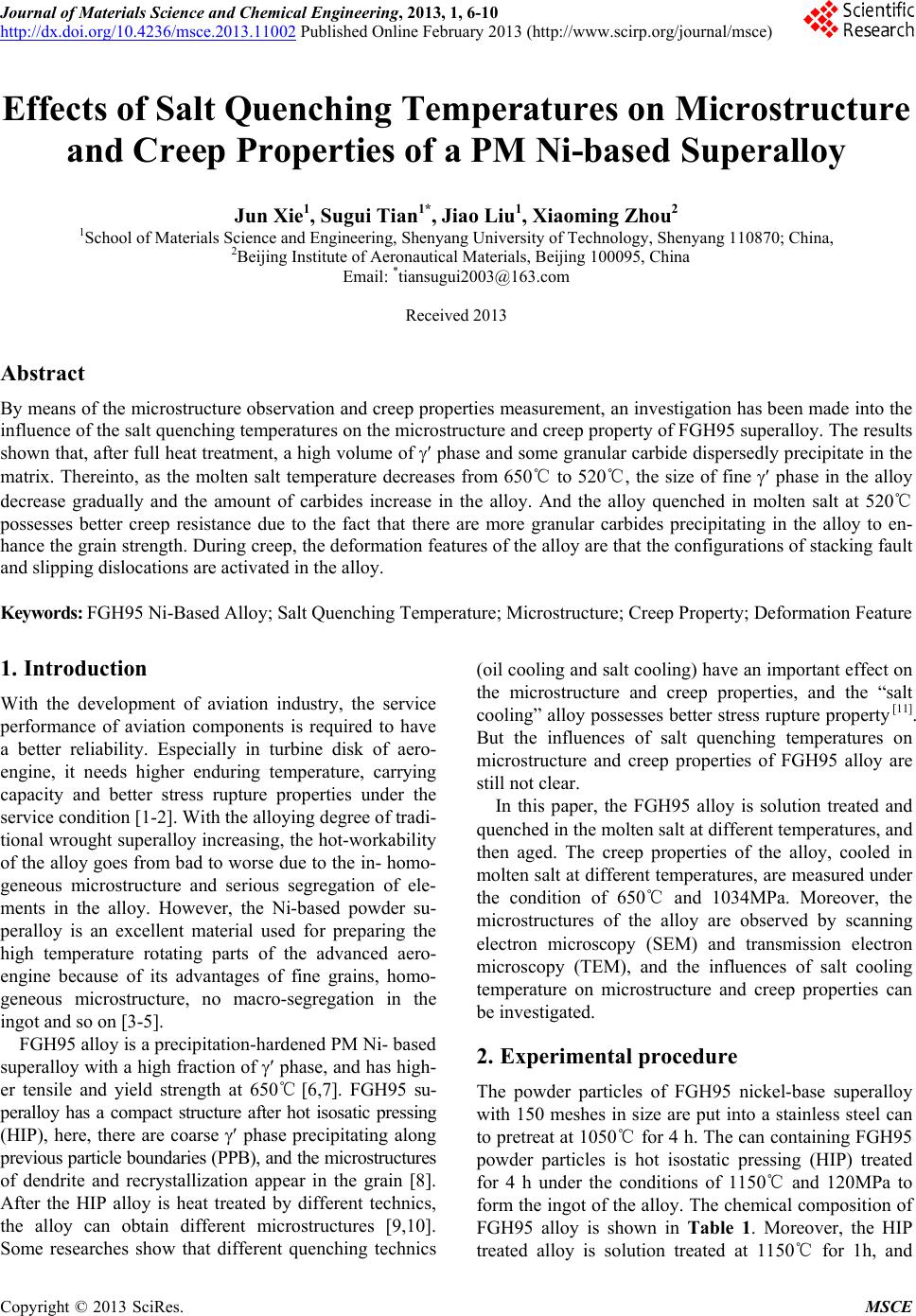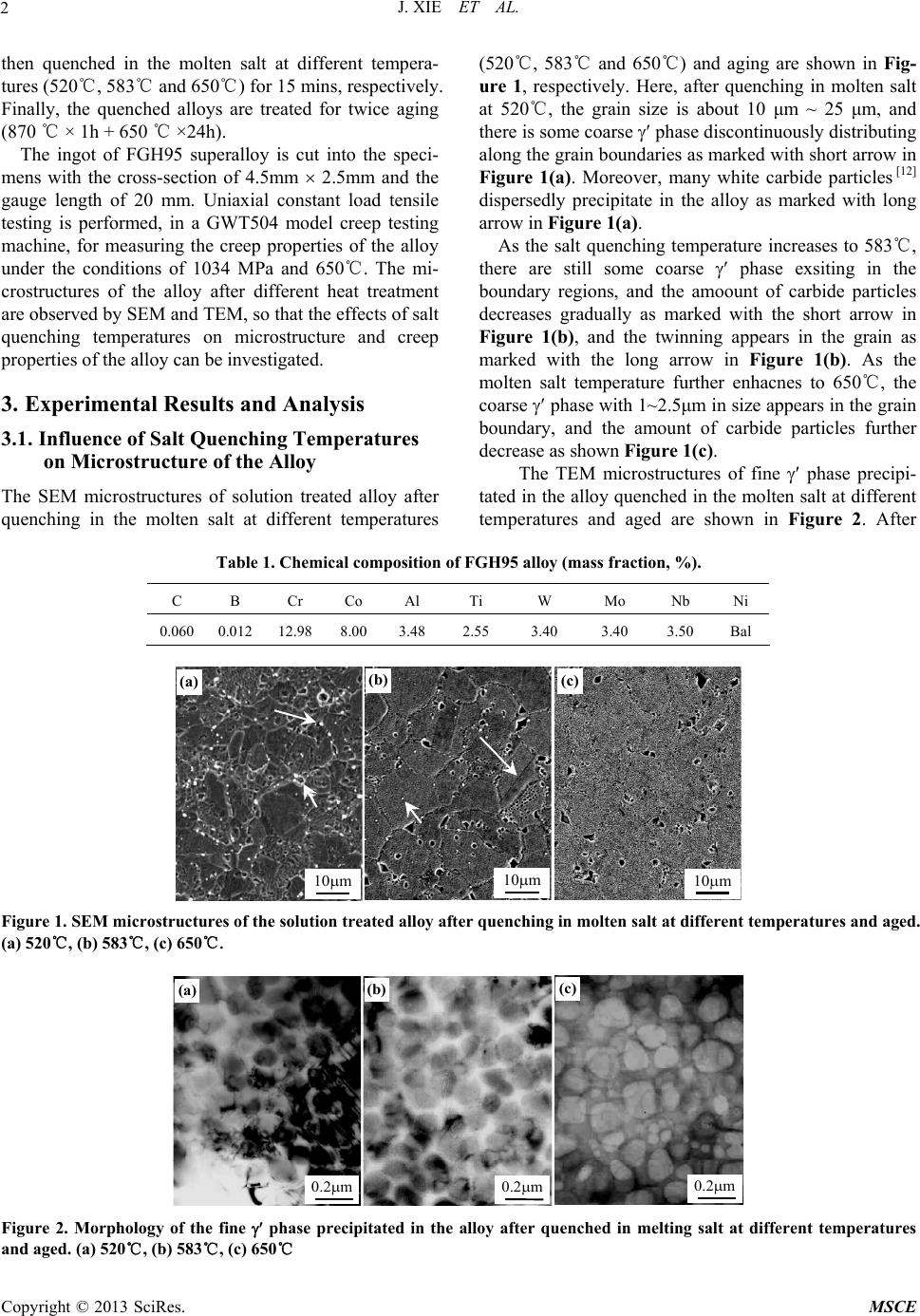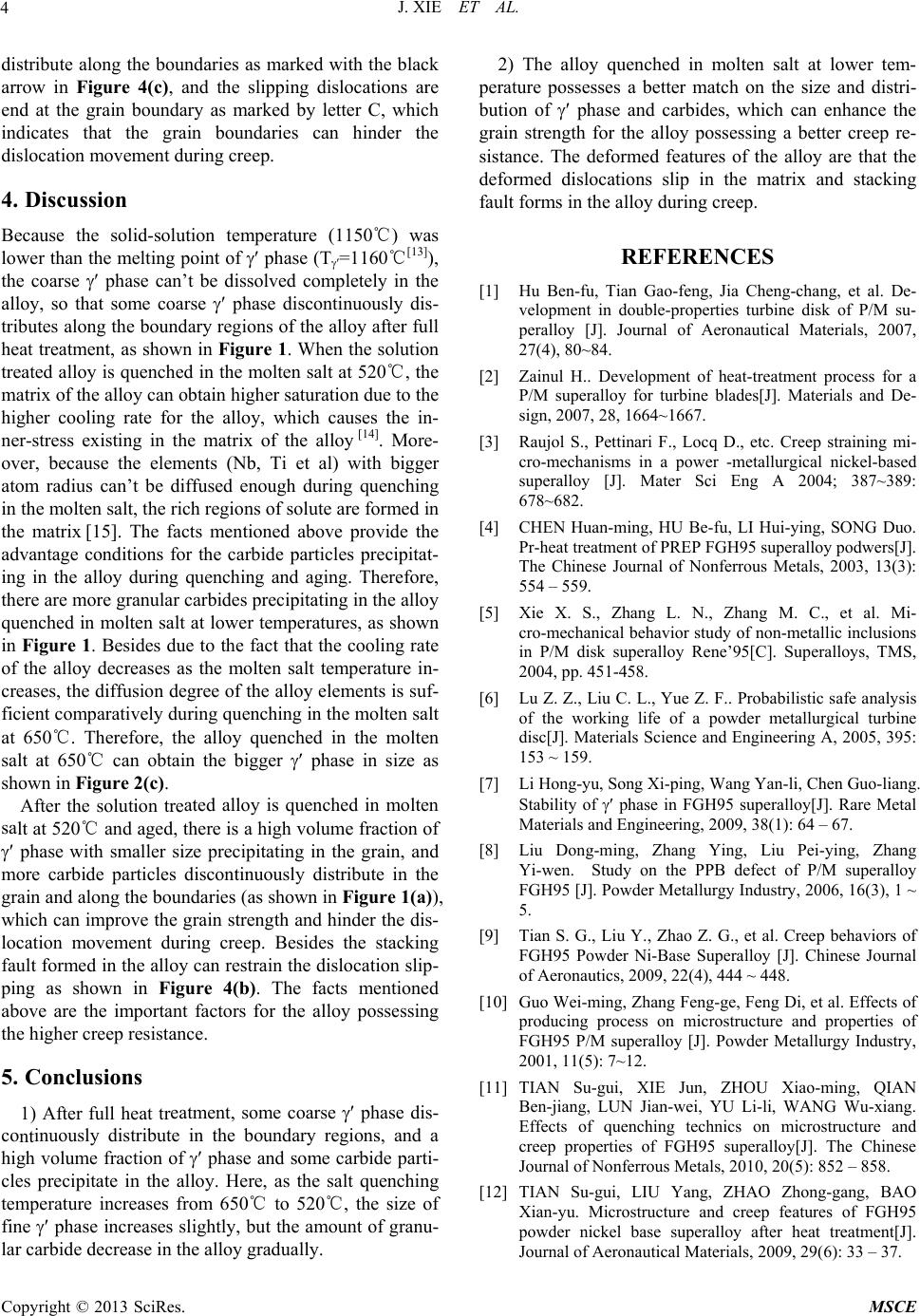Paper Menu >>
Journal Menu >>
 Journal of Materials Science and Chemical Engineering, 2013, 1, 6-10 http://dx.doi.org/10.4236/msce.2013.11002 Published Online February 2013 (http://www.scirp.org/journal/msce) Copyright © 2013 SciRes. MSCE Effects of Salt Quenching Temperatures on Microstructure and Creep Properties of a PM Ni-based Superalloy Jun Xie1, Sugui Tian1*, Jiao Liu1, Xiaoming Zhou2 1School of Materials Science and Engineering, Shenyang University of Technology, Shenyang 110870; China, 2Beijing Institute of Aeronautical Materials, Beijing 100095, China Email: *tiansugui2003@163.com Received 2013 Abstract By means of the microstructure observation and creep properties measurement, an investigation has been made into the influence of the salt quenching temperatures on the microstructure and creep property of FGH95 superalloy. The results shown that, after full heat treatment, a high volume of phase and some granular carbide dispersedly precipitate in the matrix. Thereinto, as the molten salt temperature decreases from 650℃ to 520℃, the size of fine phase in the alloy decrease gradually and the amount of carbides increase in the alloy. And the alloy quenched in molten salt at 520℃ possesses better creep resistance due to the fact that there are more granular carbides precipitating in the alloy to en- hance the grain strength. During creep, the deformation features of the alloy are that the configurations of stacking fault and slipping dislocations are activated in the alloy. Keywords: FGH95 Ni-Based Alloy; Salt Quenching Temperature; Microstructure; Creep Property; Deformation Feature 1. Introduction With the development of aviation industry, the service performance of aviation components is required to have a better reliability. Especially in turbine disk of aero- engine, it needs higher enduring temperature, carrying capacity and better stress rupture properties under the service condition [1-2]. With the alloying degree of tradi- tional wrought superalloy increasing, the hot-workability of the alloy goes from bad to worse due to the in- homo- geneous microstructure and serious segregation of ele- ments in the alloy. However, the Ni-based powder su- peralloy is an excellent material used for preparing the high temperature rotating parts of the advanced aero- engine because of its advantages of fine grains, homo- geneous microstructure, no macro-segregation in the ingot and so on [3-5]. FGH95 alloy is a precipitation-hardened PM Ni- based superalloy with a high fraction of phase, and has high- er tensile and yield strength at 650℃ [6,7]. FGH95 su- peralloy has a compact structure after hot isosatic pressing (HIP), here, there are coarse phase precipitating along previous particle boundaries (PPB), and the microstructures of dendrite and recrystallization appear in the grain [8]. After the HIP alloy is heat treated by different technics, the alloy can obtain different microstructures [9,10]. Some researches show that different quenching technics (oil cooling and salt cooling) have an important effect on the microstructure and creep properties, and the “salt cooling” alloy possesses better stress rupture property [11]. But the influences of salt quenching temperatures on microstructure and creep properties of FGH95 alloy are still not clear. In this paper, the FGH95 alloy is solution treated and quenched in the molten salt at different temperatures, and then aged. The creep properties of the alloy, cooled in molten salt at different temperatures, are measured under the condition of 650℃ and 1034MPa. Moreover, the microstructures of the alloy are observed by scanning electron microscopy (SEM) and transmission electron microscopy (TEM), and the influences of salt cooling temperature on microstructure and creep properties can be investigated. 2. Experimental procedure The powder particles of FGH95 nickel-base superalloy with 150 meshes in size are put into a stainless steel can to pretreat at 1050 for 4 h. The can containing FGH95 ℃ powder particles is hot isostatic pressing (HIP) treated for 4 h under the conditions of 1150 and 120MPa to ℃ form the ingot of the alloy. The chemical composition of FGH95 alloy is shown in Table 1. Moreover, the HIP treated alloy is solution treated at 1150 for 1h, and℃  J. XIE ET AL. 2 then quenched in the molten salt at different tempera- tures (520, 583 and 650) for 15 mins, respectively. ℃℃ ℃ Finally, the quenched alloys are treated for twice aging (870 ℃ × 1h + 650 ℃ ×24h). The ingot of FGH95 superalloy is cut into the speci- mens with the cross-section of 4.5mm 2.5mm and the gauge length of 20 mm. Uniaxial constant load tensile testing is performed, in a GWT504 model creep testing machine, for measuring the creep properties of the alloy under the conditions of 1034 MPa and 650℃. The mi- crostructures of the alloy after different heat treatment are observed by SEM and TEM, so that the effects of salt quenching temperatures on microstructure and creep properties of the alloy can be investigated. 3. Experimental Results and Analysis 3.1. Influence of Salt Quenching Temperatures on Microstructure of the Alloy The SEM microstructures of solution treated alloy after quenching in the molten salt at different temperatures (520℃, 583℃ and 650℃) and aging are shown in Fig- ure 1, respectively. Here, after quenching in molten salt at 520℃, the grain size is about 10 μm ~ 25 μm, and there is some coarse phase discontinuously distributing along the grain boundaries as marked with short arrow in Figure 1(a). Moreover, many white carbide particles [12] dispersedly precipitate in the alloy as marked with long arrow in Figure 1(a). As the salt quenching temperature increases to 583℃, there are still some coarse phase exsiting in the boundary regions, and the amoount of carbide particles decreases gradually as marked with the short arrow in Figure 1(b), and the twinning appears in the grain as marked with the long arrow in Figure 1(b). As the molten salt temperature further enhacnes to 650℃, the coarse phase with 1~2.5μm in size appears in the grain boundary, and the amount of carbide particles further decrease as shown Figure 1(c). The TEM microstructures of fine phase precipi- tated in the alloy quenched in the molten salt at different temperatures and aged are shown in Figure 2. After Table 1. Chemical composition of FGH95 alloy (mass fraction, %). C B Cr Co Al Ti W Mo Nb Ni 0.060 0.012 12.98 8.003.48 2.55 3.40 3.40 3.50 Bal (c) 10m (a) 10m 10m (b) Figure 1. SEM microstructures of the solution treated alloy after quenching in molten salt at different temperatures and aged. (a) 520℃, (b) 583℃, (c) 650℃. 0.2m (a) (b) 0.2m (c) 0.2m Figure 2. Morphology of the fine phase precipitated in the alloy after quenched in melting salt at different temperatures and aged. (a) 520℃, (b) 583℃, (c) 650℃ C opyright © 2013 SciRes. MSCE  J. XIE ET AL.3 quenching in the molten salt at 520℃, the fine phase with 0.1 ~ 0.16 μm size dispersedly precipitates in the alloy as shown in Figure 2(a). As the temperature of the molten salt increases to 583℃, the fine phase grows up slightly, and its size is about 0.12 ~ 0.18 μm as shown in Figure 2(b). As the molten salt temperature further in- creases to 650℃, the fine phase with the size of 0.15 ~ 0.2 μm appears in the grain, as shown in Figure 2(c). This indicates that the size of phase precipitated in the alloys after different quenching treatments increases slightly as the salt quenching temperature increases, therefore, the size of phase in the alloy can be adjusted by quenching in molten salt at different temperatures. 3.2. Influence of Salt Quenching Temperatures on Creep Properties of the Alloy After the alloy quenched at molten salt at different temperatures and aged, the creep curves of the alloys are measured under the condition of 650℃/1034MPa, as shown in Figure 3. Here, when the alloy is quenched in molten salt at 520℃, the alloy possesses the lowest steady strain rate about 0.00654%/h as illustrated by the curve 1 in Figure 3, and its creep lifetime of the alloy is about 70h. As the molten salt temperature increases to 583℃, the creep curve of the alloy is marked with number 2 in Figure 3, which indicates that the strain rate of the alloy is measured to 0.00789%/h during steady creep stage, and its creep lifetime decreases to 67h. The curve of the alloy quenched in molten salt at 650℃ is marked with number 3 in Figure 3, illustrating that the steady strain rate of the alloy further increases to 0.0151%/h, and the creep lifetime of the alloy further decreases to 37.2h. This indicated that the alloy cooled in the molten salt at lower temperature possesses longer creep lifetime. 3.3. The Deformed Features of FGH95 Alloy After the solution treated alloy is quenched in the molten salt at 520℃ and aged, the TEM microstructures of the alloy crept to fracture are shown in Figure 4. In the local region of the fracture alloy, the configuration of dislocation network appears in the alloy as marked with letter A in Figure 4(a). In addition, there are fine carbide particles precipitating in the grain as marked with the white arrow in Figure 4(a), and the deformed dislocations slip in the matrix and pile up near the carbide particles as marked with the black arrow. This indicates that the carbide particles can hinder the dislocation movement effectively to enhance the creep resistance of the alloy. In another region of the fracture alloy, it is clearly seen that the stacking fault appears in the alloy as marked with the arrow in Figure 4(b), and there are some deformed dislocations tangling up near the stacking fault as mark with letter B in Figure 4(b), which indicates that the stacking fault can hinder the dislocation slipping in the matrix. Figure 4(c) is another local region of the alloy crept for 70h to fracture, thereinto, the microstructure of trigeminal grain boundaries is marked by the white arrow in Figure 4(c), and some granular carbides discontinuously 0 1020304050607080 0.0 0.5 1.0 1.5 2.0 2.5 3.0 3.5 T=650oC =1034Mpa Strain ε (%) Time (h) 1 2 3 Figure 3. Creep curves of the alloy measured under the condition of 650℃ and 1034MPa. (a) A 0.3m0.2m B (b) C 0.5m (c) Figure 4. After solution treatment and quenching in molten salt at 520℃, TEM microstructure of the alloy crept to fracture under the applied stress of 1034 MPa at 650℃. (a) Dislocation network in the alloy; (b) the stacking fault appeared in the alloy, (c) slipping dislocations ending at grain boundary. Copyright © 2013 SciRes. MSCE  J. XIE ET AL. 4 istribute along the boundaries as marked with the black d arrow in Figure 4(c), and the slipping dislocations are end at the grain boundary as marked by letter C, which indicates that the grain boundaries can hinder the dislocation movement during creep. 4. Discussion d-solution temperature (1150) was ℃ ated alloy is quenched in molten sa 5. Conclusions eatment, some coarse phase dis- co 2) The alloy quenched in molten salt at lower tem- ze and distri- bu [1] Hu Ben-fu, T-chang, et al. De- velopment in e disk of P/M su- for turbine blades[J]. Materials and De- -metallurgical nickel-based atment of PREP FGH95 superalloy podwers[J]. ical behavior study of non-metallic inclusions of a powder metallurgical turbine phase in FGH95 superalloy[J]. Rare Metal peralloy H95 Powder Ni-Base Superalloy [J]. Chinese Journal nd properties of n-wei, YU Li-li, WANG Wu-xiang. 95 Because the soli lower than the melting point of phase (T=1160℃[13]), the coarse phase can’t be dissolved completely in the alloy, so that some coarse phase discontinuously dis- tributes along the boundary regions of the alloy after full heat treatment, as shown in Figure 1. When the solution treated alloy is quenched in the molten salt at 520℃, the matrix of the alloy can obtain higher saturation due to the higher cooling rate for the alloy, which causes the in- ner-stress existing in the matrix of the alloy [14]. More- over, because the elements (Nb, Ti et al) with bigger atom radius can’t be diffused enough during quenching in the molten salt, the rich regions of solute are formed in the matrix [15]. The facts mentioned above provide the advantage conditions for the carbide particles precipitat- ing in the alloy during quenching and aging. Therefore, there are more granular carbides precipitating in the alloy quenched in molten salt at lower temperatures, as shown in Figure 1. Besides due to the fact that the cooling rate of the alloy decreases as the molten salt temperature in- creases, the diffusion degree of the alloy elements is suf- ficient comparatively during quenching in the molten salt at 650℃. Therefore, the alloy quenched in the molten salt at 650℃ can obtain the bigger phase in size as shown in Figure 2(c). After the solution tre lt at 520℃ and aged, there is a high volume fraction of phase with smaller size precipitating in the grain, and more carbide particles discontinuously distribute in the grain and along the boundaries (as shown in Figure 1(a)), which can improve the grain strength and hinder the dis- location movement during creep. Besides the stacking fault formed in the alloy can restrain the dislocation slip- ping as shown in Figure 4(b). The facts mentioned above are the important factors for the alloy possessing the higher creep resistance. 1) After full heat tr ntinuously distribute in the boundary regions, and a high volume fraction of phase and some carbide parti- cles precipitate in the alloy. Here, as the salt quenching temperature increases from 650℃ to 520℃, the size of fine phase increases slightly, but the amount of granu- lar carbide decrease in the alloy gradually. perature possesses a better match on the si tion of phase and carbides, which can enhance the grain strength for the alloy possessing a better creep re- sistance. The deformed features of the alloy are that the deformed dislocations slip in the matrix and stacking fault forms in the alloy during creep. REFERENCES ian Gao-feng, Jia Cheng double-properties turbin peralloy [J]. Journal of Aeronautical Materials, 2007, 27(4), 80~84. [2] Zainul H.. Development of heat-treatment process for a P/M superalloy sign, 2007, 28, 1664~1667. [3] Raujol S., Pettinari F., Locq D., etc. Creep straining mi- cro-mechanisms in a power superalloy [J]. Mater Sci Eng A 2004; 387~389: 678~682. [4] CHEN Huan-ming, HU Be-fu, LI Hui-ying, SONG Duo. Pr-heat tre The Chinese Journal of Nonferrous Metals, 2003, 13(3): 554 – 559. [5] Xie X. S., Zhang L. N., Zhang M. C., et al. Mi- cro-mechan in P/M disk superalloy Rene’95[C]. Superalloys, TMS, 2004, pp. 451-458. [6] Lu Z. Z., Liu C. L., Yue Z. F.. Probabilistic safe analysis of the working life disc[J]. Materials Science and Engineering A, 2005, 395: 153 ~ 159. [7] Li Hong-yu, Song Xi-ping, Wang Yan-li, Chen Guo-liang. Stability of Materials and Engineering, 2009, 38(1): 64 – 67. [8] Liu Dong-ming, Zhang Ying, Liu Pei-ying, Zhang Yi-wen. Study on the PPB defect of P/M su FGH95 [J]. Powder Metallurgy Industry, 2006, 16(3), 1 ~ 5. [9] Tian S. G., Liu Y., Zhao Z. G., et al. Creep behaviors of FG of Aeronautics, 2009, 22(4), 444 ~ 448. [10] Guo Wei-ming, Zhang Feng-ge, Feng Di, et al. Effects of producing process on microstructure a FGH95 P/M superalloy [J]. Powder Metallurgy Industry, 2001, 11(5): 7~12. [11] TIAN Su-gui, XIE Jun, ZHOU Xiao-ming, QIAN Ben-jiang, LUN Jia Effects of quenching technics on microstructure and creep properties of FGH95 superalloy[J]. The Chinese Journal of Nonferrous Metals, 2010, 20(5): 852 – 858. [12] TIAN Su-gui, LIU Yang, ZHAO Zhong-gang, BAO Xian-yu. Microstructure and creep features of FGH powder nickel base superalloy after heat treatment[J]. Journal of Aeronautical Materials, 2009, 29(6): 33 – 37. C opyright © 2013 SciRes. MSCE  J. XIE ET AL.5 , Li hui-ying. The [13] ZHANG Yi-wen, ZHANG Ying, ZHANG Feng-ge, YANG Shi-zhong. The effect of solution temperature on properties of FGH95 PM superalloy manufactured by supe PREP[J]. Transactions of Materials and Heat Treatment, 2002, 23(3): 72 – 75. [14] Youdelis W V, Kwon O. Carbide phases in cobalt base ralloy: role of nucleation entropy in refinement [J]. Metal Science, 1983, 17(8): 379~381. [15] Hu Ben-fu, Chen Huan-ming, Song Du effect of pre-heating on carbide precipitates in FGH95 superalloy powders prepared by PREP [J]. Acta Metal- lurgica Sinica, 2003, 39(5): 470~475. Copyright © 2013 SciRes. MSCE |

